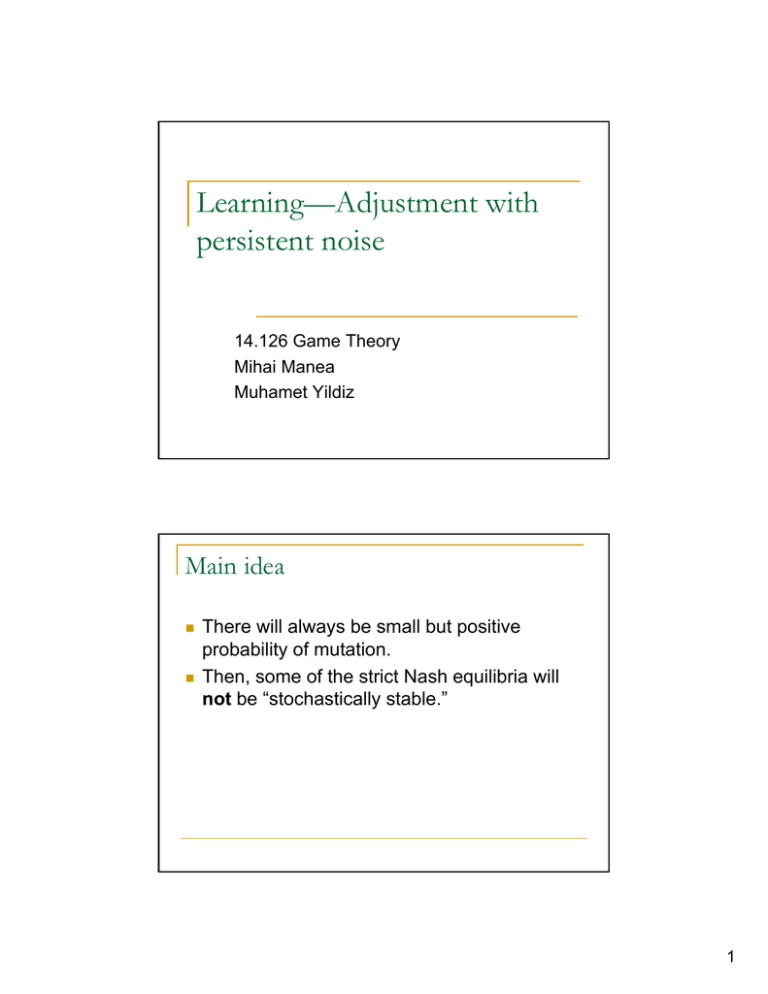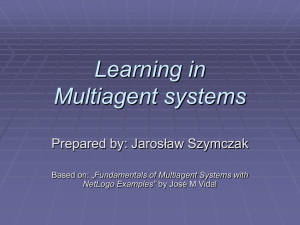Learning—Adjustment with persistent noise Main idea
advertisement

Learning—Adjustment with
persistent noise
14.126 Game Theory
Mihai Manea
Muhamet Yildiz
Main idea
There will always be small but positive
probability of mutation.
Then, some of the strict Nash equilibria will
not be “stochastically stable.”
1
General Procedure
Stochastic Adjustment
1.
2.
Consider a game.
Specify a state
space Θ, e.g., the
# of players playing a strategy. 1.
2.
A
B
A
2,2
0,0
B
0,0
1,1
Θ = {AA,AB,BA,BB}
2
Stochastic Adjustment, continued
3.
3.
Specify an adjustment
dynamics, e.g., bestresponse dynamics,
with a transition matrix
P, where
AA AB
BA BB
1
0
0
0
AA
0
0
1
0
AB
0
1
0
0
BA
0
0
0
1
BB
P=
P θ,ξ = Pr(θ at t+1|ξ at t)
φ = a probability
distribution, a
column vector.
Stochastic Adjustment, continued
4.
Introduce a small
noise: Consider Pε,
continuous in ε and
Pε → P as ε → 0.
Make sure that there
exist a unique φε* s.t.
φε* = Pε φε*.
4.
AA
AB
BA
(1−ε)2 (1−ε)ε (1−ε)ε
(1−ε)ε
ε2
Pε = (1−ε)ε (1−ε)2
ε2
BB
ε2
(1−ε)2 (1−ε)ε
ε2
(1−ε)ε
(1−ε)ε (1−ε)ε (1−ε)2
φε* = (1/4,1/4,1/4,1/4)T.
3
Stochastic Adjustment, continued
5.
6.
Verify that limε→0φε* = φ* exists; compute φ*.
(By continuity φ* = Pφ*.)
Check that φ* is a point mass, i.e.,
φ*(θ*) = 1 for some θ*.
The strategy profile at θ* is called stochastically
stable equilibrium.
Kandoori, Mailath & Rob
4
Coordination game
A
B
A
(2,2)
(0,0)
B
(0,0)
(1,1)
q
α∗=1/3
p
α∗=1/3
Adjustment Process
N = population size.
θt = # of players who play A at t.
uA(θt) = θt/N u(A,A) + (N- θt)/N u(A,B)
θt+1 = P(θt), where
P(θt) > θt Ù uA(θt) > uB(θt) &
P(θt) = θt Ù uA(θt) = uB(θt).
Example:
⎧ N if u A (θ t ) > uB (θ t )
⎪
P(θ t ) = BR(θ t ) = ⎨θ t if u A (θ t ) = uB (θ t )
⎪ 0 if u (θ ) < u (θ )
A
t
B
t
⎩
5
Noise
Independently, each agent with probability 2ε
mutates, and plays either of the strategies
with equal probabilities.
⎡ (1 − ε ) N
⎢
N −1
⎢ N (1 − ε ) ε
Pε = ⎢
M
⎢
N −1
⎢ N (1 − ε )ε
⎢⎣
εN
(1 − ε ) N
N (1 − ε ) N −1ε
...
...
(1 − ε ) N
N (1 − ε ) N −1ε
M
O
M
N (1 − ε )ε
ε
N −1
...
...
N
N (1 − ε )ε
ε
N
N −1
⎤
...
εN
εN
N −1
N −1 ⎥
... N (1 − ε )ε ⎥
N (1 − ε )ε
M
N (1 − ε ) ε
(1 − ε ) N
N −1
O
...
...
M
N (1 − ε )
(1 − ε ) N
N −1
⎥
⎥
ε⎥
⎥⎦
ϕ*(ε) = invariant distribution for Pε.
Pε
⎡
(1−ε)N
⎢
N(1−ε)N−1ε
⎢
⎢
M
⎢⎛ N ⎞
⎢⎜
⎟⎟(1−ε)N−N*+1εN*−1
⎜
N*−1
⎢⎝
⎠
⎢ ⎛ N ⎞
N−N* N*
⎢ ⎜⎜ ⎟(1−
⎟ ε) ε
⎢ ⎝N*⎠
⎢
M
⎢
εN
⎣
L
L
(1−ε)N
N(1−ε)N−1ε
εN
N(1−ε)εN−1
O
M
M
L
εN
⎛ N ⎞
L ⎜⎜
⎟⎟(1−ε)N−N*+1εN*−1
N*−1
⎝
⎠
⎛ N⎞
N−N* N*
L ⎜⎜ ⎟(1−
⎟ ε) ε
⎝N*⎠
O
M
⎛ N ⎞
⎜⎜
⎟⎟(1−ε)N*−1εN−N*+1
N*−1
⎝
⎠
⎛ N⎞
N* N−N*
⎜⎜ ⎟(1−
⎟ ε) ε
⎝N*⎠
M
(1−ε)N
εN
N(1−ε)εN−1
⎤
⎥
⎥
⎥
O
M
⎥
⎛ N ⎞
L ⎜⎜
⎟⎟(1−ε)N*−1εN−N*+1⎥
N*−1
⎥
⎝
⎠
⎥
⎛ N⎞
N* N−N*
⎥
)
L ⎜⎜ ⎟(1−
ε
ε
⎟
⎥
⎝N*⎠
⎥
O
M
⎥
N
(1−ε)
L
⎦
L
L
N* = ⎡a*N⎤ < N/2.
6
Invariant Distribution
N* = ⎡α*N⎤ < N/2.
DA= {θ|θ ≥ N*}; DB= {θ|θ < N*};
qAB = Pr(θt+1∈DA| θt∈DB);
qBA = Pr(θt+1∈DB| θt∈DA);
p A (ε ) =
ϕε (θ )
∑
θ
*
∈D A
pB(ε) = 1- pA(ε).
Invariant distribution, continued
q AB ⎤⎡ p A (ε )⎤
⎡ p A (ε )⎤ ⎡1 − qBA
=
⎢ p (ε )⎥ ⎢ q
⎥⎢ p (ε )⎥
−
1
q
B
BA
AB
⎣
⎦ ⎣
⎦⎣ B ⎦
⎡− qBA
⎢ q
⎣ BA
q AB ⎤⎡ p A (ε )⎤ ⎡0⎤
=⎢ ⎥
⎥⎢
⎥
− q AB ⎦⎣ pB (ε )⎦ ⎣0⎦
p A (ε ) q AB
=
pB (ε ) qBA
7
Invariant distribution, continued
pA (ε ) q AB
=
pB (ε ) qBA
⎛ N ⎞ N* +1
⎛ N ⎞ N*
N −N*
⎟⎟ε
⎜⎜
⎟⎟ε (1− ε )
(1− ε )N −N* −1 + L
+ ⎜⎜
⎝ N * +1⎠
⎝N * ⎠
=
N ⎞ N −N* +2
⎛ N ⎞ N −N* +1
⎟⎟ε
⎜⎜
⎟⎟ε
(1− ε )N* −1 + ⎛⎜⎜
(1− ε )N* −2 + L
⎝ N * −2 ⎠
⎝ N * −1⎠
⎛ N ⎞ N*
⎛ N ⎞
⎜⎜
⎟⎟ε (1 − ε )N −N* + o ε N*
⎜⎜
⎟
N*⎠
N * ⎟⎠
1
⎝
⎝
=
≅
→ ∞.
N −2N* +1
⎛ N ⎞ N −N* +1
⎛ N ⎞ε
N* −1
N −N* +1
⎜⎜
⎟⎟ε
⎜⎜
⎟⎟
(1− ε ) + o ε
⎝ N * −1⎠
⎝ N * −1⎠
( )
(
)
Proposition
If N is large enough so that N* < N/2, then limit
ϕ* of invariant distributions puts a point mass
on θ = N, corresponding to all players playing
A.
8
Replicator dynamics
&
Evolutionary stability
14.126 Game Theory
Muhamet Yildiz
Road Map
1.
2.
Evolutionarily stable strategies
Replicator dynamics
1
Notation
G = (S,A) a symmetric, 2-player game where
S is the strategy space;
Ai,j = u1(si,sj) = u2(sj,si).
x,y are mixed strategies; u(x,y) = xTAy;
u(s,y).
ax+(1-a)y.
u(ax+(1-a)y,z) = au(x,z) +(1-a)u(y,z)
u(x,ay+(1-a)z) = au(x,y) +(1-a)u(x,z)
ESS
Definition: A (mixed) strategy x is said to be
evolutionarily stable iff, given any y ≠ x, there
exists εy > 0 s.t.
u(x,(1-ε)x+εy) > u(y,(1-ε)x+εy)
for each ε in (0,εy].
Each player is endowed with a (mixed) strategy.
Assumes that population is a state
Asks whether a strategy (state) is robust to
evolutionary pressures.
Disregards effects on future actions.
2
Alternative Definition
Fact: x is evolutionarily stable iff, ∀y ≠ x,
1.
u(x,x) ≥ u(y,x), and
2.
u(x,x) = u(y,x) ⇒ u(x,y) > u(y,y).
Proof: Define
F(ε,y) = u(x,(1-ε)x+εy) - u(y,(1-ε)x+εy)
= u(x-y, (1-ε)x+εy)
= (1-ε) u(x-y,x) + ε u(x-y,y).
Hawk-Dove game
(1-c,1-c)
(2,0)
(0,2)
(1,1)
1. c < 1
2. c > 1
3
ESS-NE
If x is an ESS, then (x,x) is a Nash
equilibrium.
In fact, (x,x) is a proper equilibrium.
If (x,x) is a strict Nash equilibrium, then x is
ESS.
Rock-Scissors-Paper
R
S
P
R
0,0
1,-1
-1,1
S
-1,1
0,0
1,-1
P
1,-1
-1,1
0,0
Unique Nash
Equilibrium (s*,s*)
where
s* = (1/3,1/3,1/3)
s* is not ESS.
4
ESS in role-playing games
Given (S1,S2,u1,u2), consider the symmetric
game (S,u) where
S = S 1 × S 2;
u(x,y) = [u1(x1,y2)+ u2(x2,y1)]/2 ∀x= (x1,x2), y=
(y1,y2)∈ S.
Theorem: x is an ESS of (S,u) iff x is a strict
Nash equilibrium of (S1,S2,u1,u2).
Replicator Dynamics
5
θ2
BR2
BR1
• Steady state: F(θ) = θ
• A steady state θ of F is
stable iff,
∀neighborhood U of θ,
∃nbrd U1 s.t., if θ0∈U1,
Ft(θt)∈U ∀t>0.
• A steady state θ of F is
asymptotically stable
iff, it is stable and ∃U:
θ0∈U ⇒ limtFt(θt) = θ.
θ1
Replicator dynamics
pi(t) = #people who plays si at t;
p(t) = total population at t.
xi(t) = pi(t)/p(t); x(t) = (x1(t),…, xk(t)).
u(x,x) = Σi xiu(si,x).
Birthrate for si at t is β + u(si,x(t)); death rate=δ.
p& i = [β + u (si , x ) − δ ] pi
p& = [β + u ( x, x ) − δ ] p
x&i = [u (si , x ) − u ( x, x )]xi
x&i = u (si − x, x )xi
6
Example
Consider (S,A) where A = ⎡
⎢
a1
⎣0
0⎤
a2 ⎥⎦
u(s1,x) = a1x1; u(x,x) = (x1,x2)A(x1,x2)T = a1x12 + a2x22
u(s1-x,x) = (a1x1 - a2x2)x2
x&1 = (a1 x1 − a2 x2 )x1x2
Examples
Replicator dynamics in prisoners’ dilemma
Replicator dynamics in chicken
Replicator dynamics in the battle of the
sexes.
7
Observations
x
d ⎡ xi ⎤ x&i xi x& j
x
x
= [u(si , x) − u ( x, x )] i − i [u(s j , x) − u ( x, x )] j
⎢ ⎥= −
dt ⎢⎣ x j ⎥⎦ x j x j x j
xj xj
xj
= [u(si , x) − u(s j , x)]
xi
xj
If u becomes u = au+b, then Replicator
dynamics becomes
x&i = u (si − x, x )xi = au (si − x, x )xi
Rationalizability
ξ(.,x0) is the solution to replicator dynamics starting at x0.
Theorem: If a pure strategy i is strictly dominated (by y),
then limt ξi(t,x0) = 0 for any interior x0.
Proof: Define vi(x) = log(xi) – Σjyjlog(xj). Then,
x&
dvi ( x(t)) x&i
= − ∑ j y j j = u(si − x, x) − ∑ j y j u(s j − x, x) = u(si − y, x).
dt
xi
xj
Hence, vi(x(t)) →-∞., i.e., xi(t) → 0.
Theorem: If i is not rationalizable, then limt ξi(t,x0) = 0 for
any interior x0.
8
Theorems
Theorem: Every ESS x is an asymptotically
stable steady state of replicator dynamics.
(If the individuals can inherit the mixed
strategies, the converse is also true.)
Theorem: If x is an asymptotically stable
steady state of replicator dynamics, then (x,x)
is a perfect Nash equilibrium.
9
MIT OpenCourseWare
http://ocw.mit.edu
14.126 Game Theory
Spring 2010
For information about citing these materials or our Terms of Use, visit: http://ocw.mit.edu/terms.


